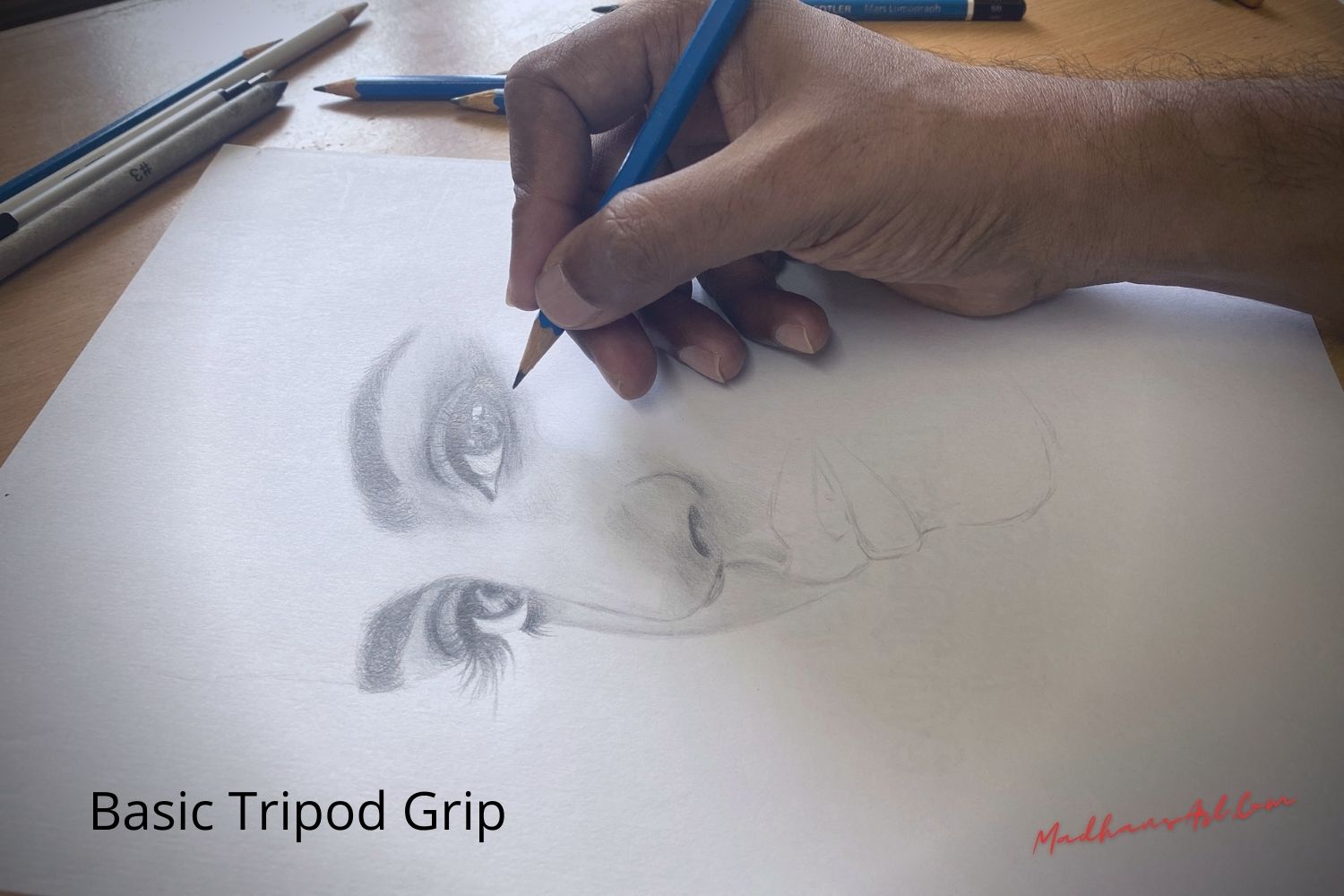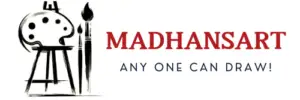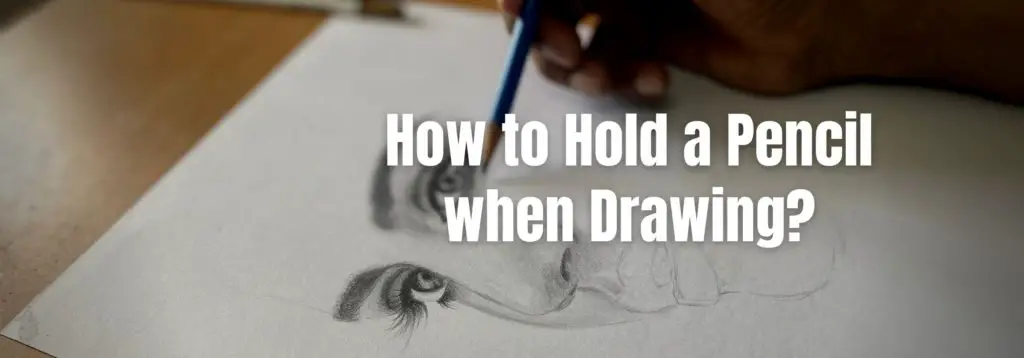I never knew there were different ways to hold a pencil when drawing, and I used to hold it the same way I held it when I wrote.
There is a vast difference between holding a pencil when drawing and when writing. The sooner you realize and change it will help you to improve your drawing significantly.
When writing, the distance of the impression to be covered on the paper is small, so you will hold the pencil near the tip and have absolute control.
When drawing, the graphite impression needs to cover a broader area on the paper, and your hand needs to move freely.
Table of Contents
So how to hold a pencil when drawing?
How to hold a pencil when drawing depends on what you want to draw. Again, drawing is an extensive terminology that covers many things like pencil strokes, pencil shades, creating values, depth, etc., and it all depends on what you want to draw. The following are the many ways to hold your pencil, and the main reason we hold it that way is:
- Basic Tripod Grip – Used when you want to do short strokes with precision
- Extended Tripod Grip – Used when you do longer stroke and free and controlled line
- Overhand Grip – Used for Shading, and every stroke will be broad and less precision
- Underhand Grip – This method has loose strokes and is mainly used for creating pencil textures
We shall understand these methods in detail with reasons. Another important thing while holding the pencil is the movement of your finger, wrist, and hand.
These movements of your body parts and how you hold your pencil will improve the quality of your drawing.
Precision is what you want to cover, and the type of stroke decides how you need to hold your pencil.
Different methods give you options and variety for your drawing, making you efficient and saving time.
A word of caution, you should never change how you hold the pencil just by reading this post.
I want you to feel what I am saying, test, and practice it, and if you consciously realize that it makes sense, and more than that, if you are feeling comfortable, you should only change.
If you change for the sake of changing, it will stress you greatly, resulting in losing interest in drawing. I do not want that to happen, so if you are comfortable, only then should you change.
Basic Tripod Grip:

This is the general method most of us follow when writing or drawing; hence, it is also called the writing method.
Under this method, the thumb and the index finger hold the pencil, the pencil rests on the middle finger, and the wrists move to create an impression.
As three fingers are used, it is called the Tripod grip method.
One will hold the pencil a bit tight when using this method.
You rest your hand on the surface of the paper, which restricts the movement of a pencil to the movement of the wrist, thereby limiting the length of the strokes.
Why do you use the Basic Tripod Grip method?
This method is used when doing precision drawing and when you want to have fine lines or strokes.
The pencil point must be sharp, and the pencil’s tip should be less than 2 inches below your hand. The pencil is at an angle between 50 degrees to 90 degrees.
The pencil may be pressed on the paper, hard or soft, depending on the quality of mark-making you require.
An artist uses this method for drawing or when doing some detailed pictures, like drawing hair or thin lines.
This method can also be done when doing doodle art as they have detailed and multiple strokes. This method is used when drawing for a sketchbook or miniature artwork.
Most of us use this essential and vital method, but I recommend mastering the wrist movement to improve your artwork.
Extended Tripod Grip:

This method is used by Professional Artists who freely draw their sketches on paper.
This is like the primary tripod grip method; the only difference is that the hand will be between two and four inches away from the pencil’s tip.
The pencil angle will be between 30 degrees to 50 degrees angle from the surface of your artwork.
The thumb holds the pencil and the index finger, and the pencil rests on the middle finger. In this method, the wrist may or may not rest on the paper and can be moved freely.
As this method is like the basic tripod grip method, you may adopt this method without much resistance.
Why do you use the extended tripod grip method?
Since the tip of the pencil is far from the finger, you can quickly move your wrist, which will help you to draw long lines or smooth curves.
Using this method, avoid your hand from smudging the paper. While using this method, you should draw light strokes and use a slow layered approach.
Overhand Grip:

As the name denotes, under this method, you will be holding your hand over your pencil, and this method is quite popular amongst Artists.
You shall use your thumb and other fingers to hold the pencil and your whole wrist to move the pencil.
You can use both the tip and the side of the pencil in this method. When using the side of the pencil, it will be able to cover a wide area.
When you use the side of the pencil, it is for shading or drawing lines on a bigger surface.
In other words, this method can get a thick and thin line.
But my suggestion is when drawing thick or thin lines, do not put too much pressure on the pencil. Use it lightly, and try to draw multiple layers if you want to darken a stroke or an area.
The overhand grip method gives so much freedom when drawing and is mainly referred to as the proper way of holding a pencil.
If you have not heard about the overhand grip method or are trying out this only now, it is worth trying.
With the way how you hold your pencil, and the amount of pressure that you apply on the paper, and with different types of pencil which you can use, there is an infinite possibility of results you can get using the overhand grip method.
Madhansart.com
An example where an overhand grip is used is gesture drawing, long strokes, and free curves. It would help if you did these drawings freely; the overhand grip method is best.
Underhand Grip:

Following this method, you can draw with the whole hand and not with your finger or wrist.
This gives you total freedom to move your hand, usually on a bigger paper. You will hold the pencil on the top with your thumb and below with your index finger supported by the remaining three fingers.
Using this method, you can draw gesture drawings or drawings for casual or rough purposes.
If you are new to this type of pencil-holding method, it will be a bit difficult, but with practice, it will make you comfortable, and I am sure you will like it.
An artist keeps his pencil less than 20 degrees when using this method. The lead should be slightly longer and, when kept slanting, will give good shade.
There is not much difference between the overhand grip method and the underhand grip method.
You can draw straight, long lines and smooth curves, and with practice, you can even draw a proper circle or any such thing.
These are not the only methods to hold your pencil, but this is what most artists use.
You should pick up a reference picture and start practicing different methods. See how comfortable you are.
Initially, you may find it a bit weird, but with practice, I think you should be fine. Even after practice, if you are uncomfortable with any method or changing how you draw, do not force yourself.
Conclusion
Once you get a grip (pun intended) on all the above methods, you should use the methods appropriately.
To elaborate, if you are doing fine work, like drawing eyelashes or eyebrows, you should use a tripod grip method. If you are doing some gesture drawing, you should use either the overhand or underhand method.
These methods also, if used appropriately, will optimize the drawing process and save time.
Which method are you comfortable with? Please leave your comments below.
By mixing different methods, you can create different varieties of drawings, and you can explore the limitless wonders of the art world.
Frequently Asked Questions
-
How do most artists hold pencils?
To achieve quick and accurate lines, most artists maintain a light grip around their pencil’s barrel with the help of their thumb and middle finger. Additionally, some rotate their pencils in various directions while drawing or shading to create a range of line widths and more control over the amount of pressure applied to the paper.
-
How should a beginner artist hold a pencil?
As a beginner artist, the best way is to position your thumb and index finger around the shaft with the middle finger supporting from behind. Make sure to hold tight enough, or you will restrict control over line work and shading. Similarly, if kept too loosely, you will also hamper accuracy. Furthermore, applying pressure in different areas while shading until finding a grip suited for those tasks becomes naturalized through practice.
-
How do animators hold pencils?
The core elements of an animator’s grip include holding the pencil between their thumb and forefinger, with their middle finger resting on the back of the shaft. Animators should adjust the pressure they are using when drawing to ensure they can produce the desired effect. It is also beneficial to vary your grip slightly depending on your drawing, as this can help create different styles or textures.
-
How do digital artists hold pencils?
To work on digital artwork, artists should delicately hold a pencil or stylus between their thumb and forefinger, balancing the back of its shaft with their middle finger. This grip gives them optimal control and accuracy when creating onscreen masterpieces. Additionally, it is critical to vary the pressure applied when sketching for various textures, styles, and effects.
-
Why do artists hold their pencils up?
Artists use their pencils up when drawing to allow for maximum control and precision. With a sturdier grip, an artist can create finer lines with greater accuracy and apply different pressure levels for unique outcomes. Furthermore, it aids in decreasing fatigue and unpleasantness felt in the arm.
-
Should I draw with my wrist or arm?
When drawing with a pencil or stylus, the perfect technique combines wrist and arm movements for maximum control and accuracy. Flourishing your wrist leads to slower, less precise lines, whereas relying primarily on your arm can lead to an absence of finesse and detail. To get the best results, utilize both motions. Let your wrist handle more intricate details while using your arm for broader strokes that require more power.

